| | Summary and Introduction | Agronomics | Economics | Future of Soybeans in Alberta | Footnotes | Acknowledgements
Summary and Introduction
Soybeans are an important warm season oilseed crop, with production occurring throughout the world. The crop is processed (crushed) to produce a highly desired protein meal for animal diets, as well as vegetable oil for human consumption. Alberta swine and poultry producers currently import large quantities of soybean meal from the U.S. Agronomically, soybeans have the advantage of fixing nitrogen when properly inoculated, and do not require a lot of specialized equipment to grow. In Alberta, soybeans are grown on a limited scale on irrigated land in Southern Alberta but do not compete well for acreage with higher value irrigated crops. However, in recent years we have seen a rapid increase in soybean production in Manitoba and Saskatchewan, demonstrating that soybeans can find a place in dry land crop rotations where growing conditions are favorable. Furthermore, agricultural technology companies are developing shorter season varieties which may be suitable for production in larger areas of Alberta. The need to export soybeans initially will tend to widen Alberta’s soybean basis, a disadvantage for local producers. With a wide soybean basis and a large positive basis for soymeal, the economics of soybean crushing in the province could be attractive. But it will probably take a dramatic increase in acreage in order to entice soybean processors to set up in the province. Overall, soybeans are a crop with good future potential but significant obstacles in our province. It is likely that the pace of adoption of soybeans in Alberta will be slower than for grain corn.
Agronomics
Heat Requirements
Soybeans are sometimes referred to as “short-day plants”, as they flower in response to shortened day length. Latitude greatly affects day length, so geography plays a very important role in the production of soybeans. Because of this, each variety has a very narrow north-south range of adaptation, usually no wider than 150-250 kilometers. Varieties grown south of their maturity band will mature earlier than normal, resulting in reduced yield. Varieties grown further north than their maturity band will mature later and be at a greater risk of a killing frost. If a season-ending freeze hits soybeans before they reach physiological maturity, both yield and quality will be affected. Therefore, choosing a variety that reaches maturity within your area’s growing season is very important1 2 .
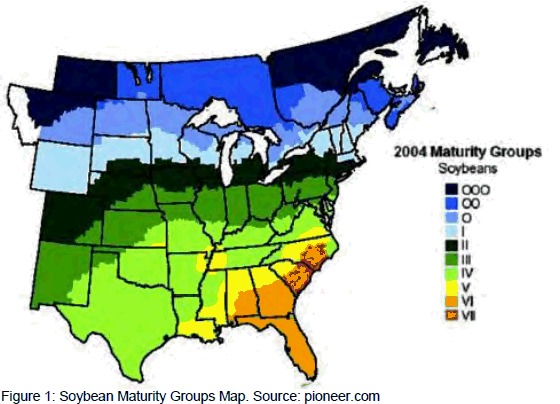
Corn Heat Units (or CHU’s) are used to measure the amount of heat available in an area during the growing season. Soybean breeders often use CHU ratings to indicate the heat requirement of soybeans. The following table demonstrates several soybean varieties, their individual CHU ratings and their performance at various Alberta locations.
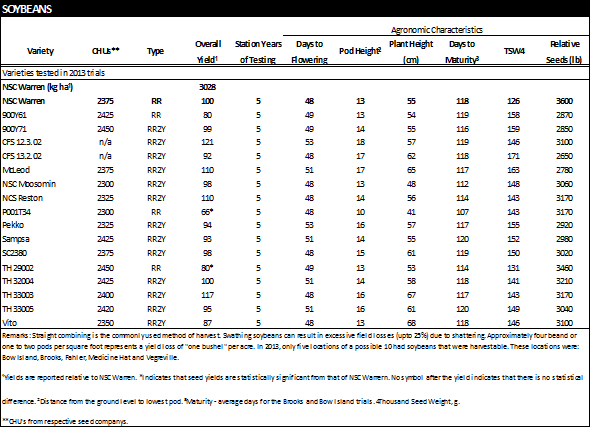
Figure 2: Soybean Varieties 2014. Adapted from: AARD, Agri Facts, "Varieties of Pulse Crops for Alberta" Agdex 142/32-1
Note that the earliest varieties are listed at 2300 CHUs and that the majority of available varieties are closer to 2400 CHUs. This is in contrast to grain corn, where there are commercial varieties already available for as low as 2050 CHUs. This suggests that soybeans are several years behind corn in terms of the development of early maturing varieties suitable for Alberta’s growing conditions. Current varieties could only be recommended for several counties in the south-eastern corner of Alberta, as shown in Figure 3. Similar to corn, it is expected that the coming years will see the introduction of new lower heat unit varieties, which will expand the potential range of this crop in Alberta. It is probably too early to speculate how much the potential range of this crop could increase.
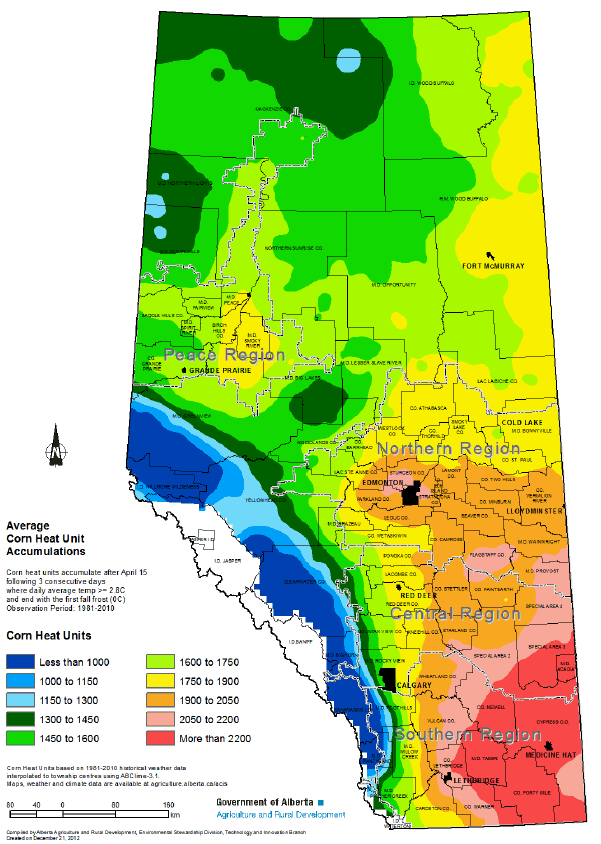
Figure 3: Average CHU Accumulation. Source: http://www.agriculture.alberta.ca/acis/climate-maps.jsp
Water Requirements
The water requirement for soybeans varies between 450-700 mm per season, depending on climate and length of the growing period3. In the US, soybeans aren’t typically grown under irrigation, since growing areas get moisture during the critical flowering and pod-fill period during late July and August. However, in Alberta irrigation will likely be needed to ensure adequate moisture during these critical times of growth and maximum yield potential4. Certainly within the regions of the province where soybeans are currently adapted, irrigation is a requirement. As shorter season varieties are developed, we could see selected areas where there is a combination of sufficient heat and timely summer rains, for example in the Edmonton region.
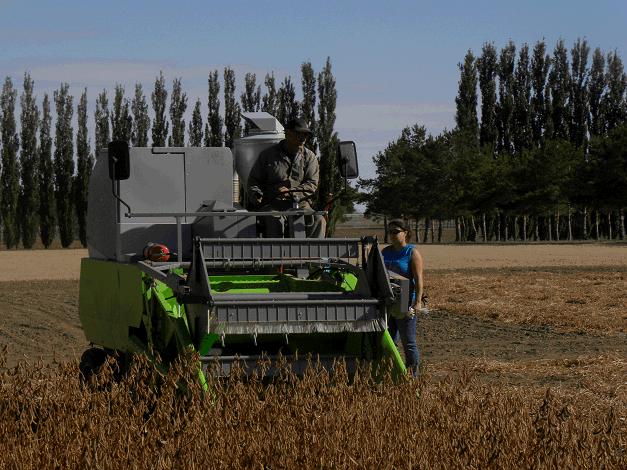
Harvest of soybean experimental plots at CDC South, Brooks, Alberta on October 7, 2014
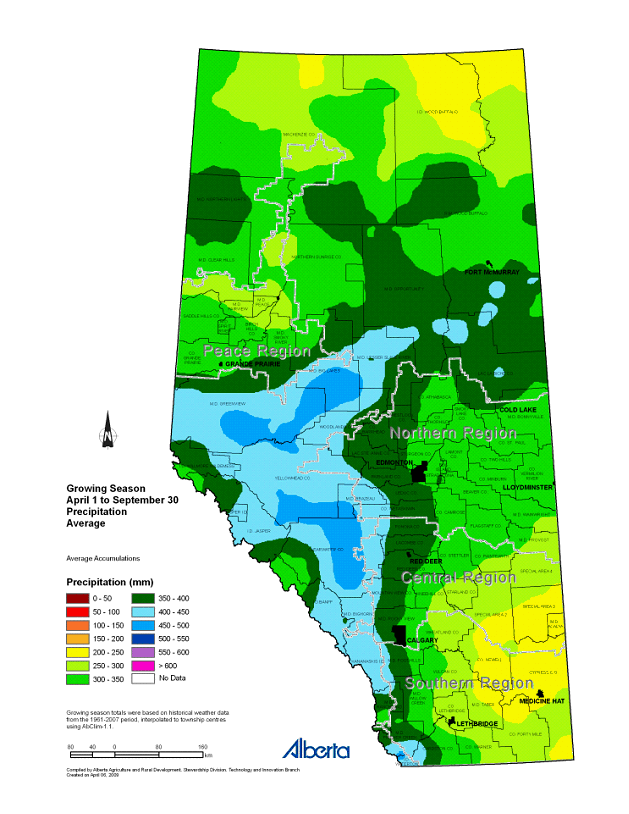
Figure 4: Growing Season Precipitation Average. Source: http://agriculture.alberta.ca/acis/climate-maps.jsp
Agronomic Considerations
Nitrogen Fixation
Soybeans, if properly innoculated, are capable of fixing nitrogen from the atmosphere. This gives them the ability to add nitrogen to the soil, approximately one pound per every bushel produced, providing ‘free’ nitrogen to benefit subsequent crops5. Inoculation is important because our soils will not normally contain the required bacterium.
Pests and Diseases
Soybeans and Canola share common pests and diseases, including soil-borne diseases such as root rots and seedling blights. Sclerotinia stem rot, or white mold, is among the greatest disease corncerns for soybeans on the Prairies. Sclerotinia is typically considered a disease of canola, however the spores are capable of infecting other species, including soybeans. These spores are capable of surviving over winter in the soil and can cause significant losses in soybeans when they are planted in infested soil. This can become a persistent problem in wet conditions, particularly among irrigated soybeans.
The soybean cyst nematode is another potential issue of increasing soybean production on the prairies. This microscopic worm causes the greatest yield loss of any soybean pathogen in the U.S. It has been identified in North Dakota, including areas along the Manitoba border near areas where the province’s soybeans are grown. It is a soil-borne pathogen, and so anything that can move soil can also move the soybean cyst nematode. Once established in a field, it is nearly impossible to remove6 .
Equipment Requirements
Soybeans can be seeded using a row crop planter, air planter, grain drill or an air seeder. Harvesting is most commonly done by straight combining . Use of equipment such as floating headers, pickup reels, love bars, and row crop headers can help reduce harvest losses. Swathing soybeans is not recommended, as it can cause significant (up to 25%) yield losses
due to shattering7 . In contrast to corn, producers will be able to try soybean production with limited investment in specialized equipment.
Harvesting of soybeans can begin at moisture levels below 20%, but they must be stored below 14%. All drying methods are acceptable to soybeans, but there are some restrictions on handling methods and the use of heat. Seed coat splitting can be an issue with drying, most commercial drying recommendations suggest a maximum temperature of 55-60�C. Natural air drying is also an option, but only under the right conditions8.
Acreage Trends
The majority of Canadian soybean acres are currently in Ontario, however, this crop has begun making its way west. The acreage of soybeans grown in Manitoba has grown very quickly since they were first reported in 2001, exceeding 500,000 seeded hectares this year. Manitoba’s climate is well suited to soybeans, with the right combination of heat and rain. The crop has earned a regular spot in crop rotations, benefitting further from the close proximity of large soybean crushing plants to the south. Soybeans have just made their way into Saskatchewan’s crop reporting data, with 68,800 seeded hectares reported for 2013 and 121,400 hectares for 2014 9 . Expansion is occurring primarily is south eastern Saskatchewan.
Currently, Statistics Canada does not gather data on soybean production in Alberta. However, industry estimates suggest 10,000 to 12,000 acres of soybeans (approximately 4050 hectares) were seeded in 2014.
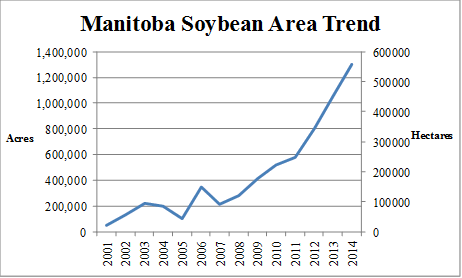
Figure 5: Manitoba Soybean Area Trend. Source: Statistics Canada Table 001-0010 and 001-0017
Economics
Cost of Production
Cost of production data for soybeans specific to Alberta has not been published but there is ample information from nearby regions. However, it is important to note that in nearby states and provinces, soybeans are grown as a dry land crop, while Alberta producers will face additional irrigation expenses. Furthermore, the high value of irrigated crop land in Southern Alberta is felt to be a limiting factor to the adoption of soybeans in the province. There are many cropping options in the southern irrigated region, including high value crops such as potatoes and sugar beets. Even though input costs are relatively low, the gross revenue from an irrigated soybean crop is modest compared to many other cropping choices. This could make it difficult for soybeans to compete for a regular place in irrigated crop rotations.
Given the strong acreage trends in Manitoba and Saskatchewan, it is obvious that soybeans compete well against other prairie dry land crops for a space in farmers’ rotations. The benefits of nitrogen fixation on subsequent crops potentially gives soybeans an edge in comparison to canola.
Cost and Return Budgets – Other Regions
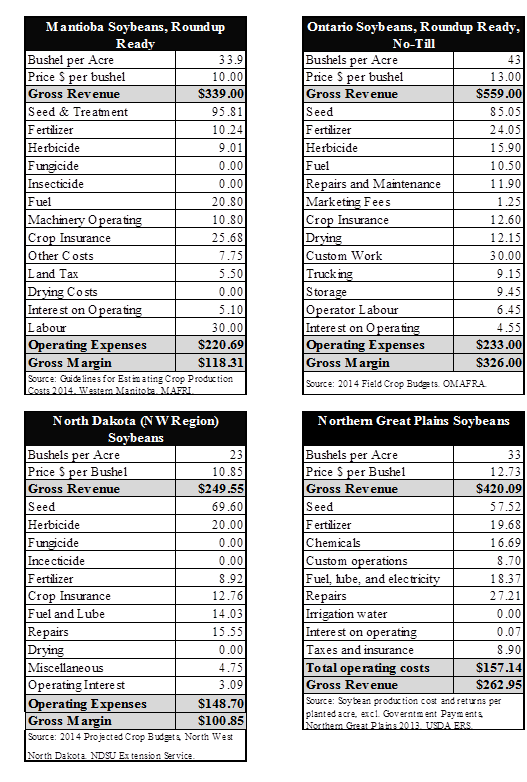
U.S. and Northern Great Plains
The Northern Great Plains region of the U.S. is closest to Alberta in climate, and so they serve as a useful point for comparison. Profitability of soybeans in the Northern Great Plains tends to fall below the overall U.S. average profitability. This is likely due to the lower yields realized in the Northern areas of the U.S. North Dakota (as is shown in figure 7), has consistently had yields lower than the U.S. average since 1997.
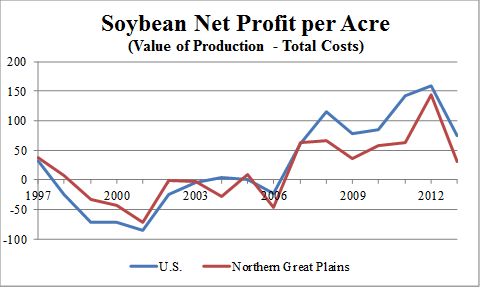
Figure 6: Soybean Net Profit per Acre. Source: USDA ERS
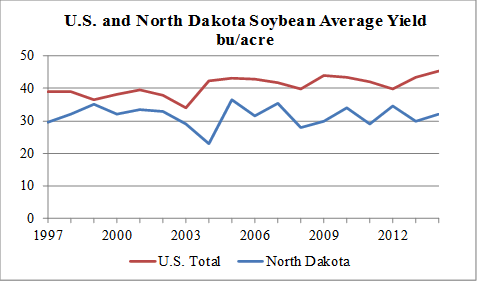
Figure 7: U.S. and North Dakota Soybeans Average Yield. Source: USDA NASS
Comparison of Gross Margins amongst Northern Great Plains cropping options shows that Soybeans are a competitive crop in this region. Soybeans tend to bring greater returns than 12
wheat and barley, and are competitive with corn. Input costs tend to be low for soybeans in the U.S. Relatively little fertilizer and chemical are applied to soybean crops and since they have been grown in the U.S. for many years, many soils have built-up their rhizobia populations and little (if any) inoculant is needed.
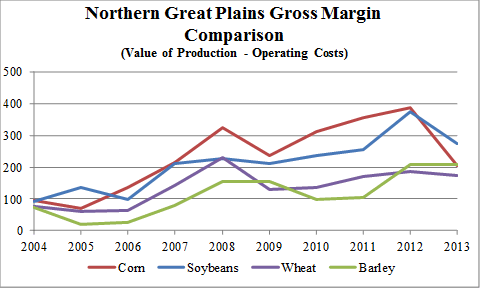
Figure 8: Northern Great Plains Gross Margin Comparison. Source: USDA ERS
Livestock Feed
Soybean meal is the most popular protein supplement in livestock feeds globally, particularly in poultry and swine (monogastric) diets. It has the highest protein content and digestibility amongst all of the plant-based protein sources and a near-ideal mix of essential amino acids. When soybean meal and corn are combined, they can serve as the basis for both swine and poultry diets, providing most of the essential nutrients with only a small amount of supplement being needed. Therefore, soybean meal is the preferred source of protein for monogastric livestock. Pork and poultry production in Alberta already has a demand for soybean meal, which is currently met by imports.
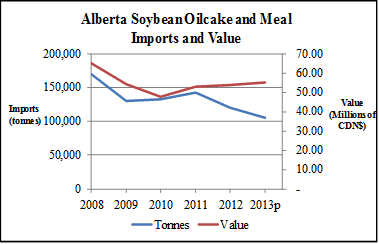
Figure 7: Alberta Soybean Oilcake and Meal Imports. Source: Statistics Canada and Alberta Ag and Rural Development.
Since there is no local soymeal supply, Alberta livestock producers will also use canola meal, field peas and wheat dried distiller’s grains with soluble (DDGS) for their protein source. This is because soybean meal is very expensive relative to these other alternatives. It must be trucked in from the U.S., usually Minnesota to Manitoba then over to Alberta. This adds considerable transport costs to the price and forces producers to look for more cost effective alternatives10 . Yet even with the higher cost of soymeal, it still captures a large share of monogastric rations in the province. We estimate in 2013, that 55% of Alberta pork and poultry protein requirements were met by imported soymeal11.
There is potentially a large demand for soybean meal from Alberta’s pork and poultry producers, if local supplies become available to make soybean meal cost-competitive. The following estimate for potential soybean meal consumption was made by estimating the portion of diet that is composed by soybean meal, calculating total per-animal consumption and multiplying that by Alberta’s 2013 number of animals produced. Based on current production figures, 182,172 tonnes of soybean meal could potentially be consumed by Alberta’s poultry and pork industry annually.
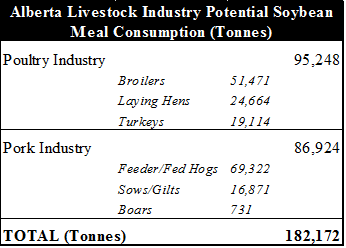
Figure 8: Alberta Livestock Industry Potential Soybean Meal Consumption
Oil Crushing
Soybeans must be processed in order to render useful products for livestock and human consumption. The end market for every soybean grower is a “crusher”, the processing plant which separates the oil and meal components. For regions such as Alberta, without a large soybean crushing plant, it is necessary to export the raw beans, adding to the cost of production. The “Catch-22” for new soybean production regions is that processors are looking for large acreages before they consider a plant investment, while farmers are looking for a local crushing market before they consider expanding acreage.
In the U.S. the average soybean processing facility capacity is around 2500 tonnes per day, approximately 900,000 tonnes per year. Conventional chemical extraction processing plants need to reach certain economies of scale, at least 1500 tonnes per day, to be feasible. To support the smallest of these chemical crush plants, around 10-15 million bushels (290,000- 430,000 acres of production, given an average yield of 35 bushels per acre) of soybean production would be needed annually. There are some plants, which employ mechanical crush technology, which can operate on much smaller scales. For example, there is a plant in New York which processes only 150 tonnes per day. These plants tend to serve specialty markets; however, they are at a disadvantage in the meal market. This is because the meal they produce has more oil, therefore higher fat concentration. Although this meal is acceptable to the dairy industry, pork and poultry producers won’t pay premiums for the extra oil content, since it can affect ration formulations.
In Canada, there are some soybean processors, primarily located in Ontario and Quebec. The average size of these eastern plants is around 3000-3500 tonnes per day. There is also one plant currently operating in Manitoba, south of Winnipeg, which processes 150 tonnes per day. This provides some local market for Manitoba’s 1.1 million tonnes of soybean production, but most of their crop is still exported out of the province.
There may be some soybean crush potential in conjunction with the existing canola crushing industry. It is possible to build plants that have the ability to crush both canola and soybeans12. In Canada there are a total of 13 canola crush plants, 10 of which are located in the Prairie Provinces. Therefore, there may be some opportunity to engage in soybean crushing alongside canola as soybean production expands13 .
Future of Soybeans in Alberta
Investment in new soybean varieties which are better suited to the Albertan climate is underway by private companies. Representatives from these companies indicate that earlier maturity traits are the main focus in developing varieties for this region. Their target is to get down to a soybean that can mature around 2000 CHU’s with a yield that can compete with existing crops. There are currently some lower CHU varieties undergoing trials.
Soybeans are an appealing crop to producers because they reduce nitrogen costs and no large investments in different equipment will be needed. However, the adoption rate of soybeans is somewhat uncertain at this time. Varieties suited for most of Alberta are still undeveloped, and it is unlikely that significant growth in soybean acres will be seen before the introduction of early maturing varieties suitable for non-irrigated regions. Expansion of soybean acres is also contingent on the relative profitability of the crop. There are many options available for irrigated acres, and producers will not adopt soybeans into their rotation unless their value justifies it. Finally, the distance to the nearest crushing facility will widen soybean basis, in contrast to grain corn, which has a ready market locally.
However, soybean acres have grown rapidly in south eastern Saskatchewan and industry professionals do anticipate Alberta to follow this trend in the future. The biggest hurdle that must be cleared is the introduction of earlier maturing varieties. Following their introduction, it is expected that producers will begin to try soybeans out on a small scale. Once confidence in growing the crop is established, they expect rapid growth in acres, likely around the year 2020 14 15 . It is likely that processors will want to see evidence of a strong acreage trend before investing in crushing capacity. Smaller cold press facilities will likely lead the way, filling some of the local demand for soybean meal.
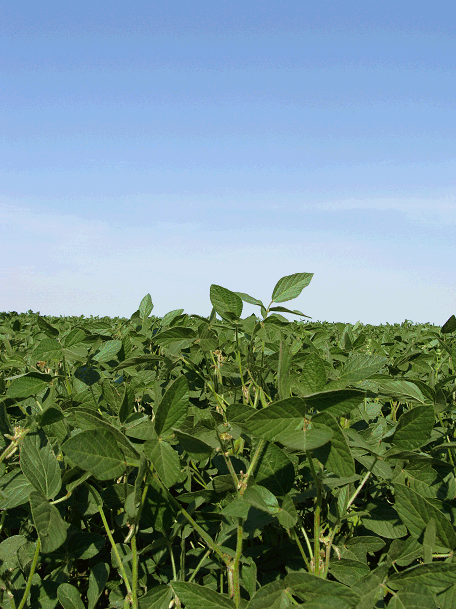
Irrigated soybean field near Brooks, Alberta
Disclaimer: The purpose of this report is to provide background information and to encourage discussion on the topic of soybeans expansion in Alberta. Opinions expressed are either attributed to others or those of the authors, and do not necessarily represent the policies or the view of the Government of Alberta. The authors wish to thank the many contributors to this report and also to acknowledge the financial contribution of Growing Forward II
Footnotes
1 Kandel, H. (2013) “Soybean Production Field Guide for North Dakota and Northwestern Minnesota”. North Dakota State University Extension Service
2 DuPont Pioneer. (2010) “Soybean Variety Maturity Ratings”. Field Facts. Vol. 6. No. 7. Pg 1.
3 FAO Water Development and Management Unit. (2013) “Crop Water Information: Soybean”. http://www.fao.org/nr/water/cropinfo_soybean.html
4 Manjula Bandera, Research Scientist Pulse and Special Crops, AARD. Personal Communication.
5 Dixon, P. “Soybean Production in the Yellowstone Valley”. Montana State University Extension.
6 Friesen, R. (2014)“Diseases You May Not Have Thought Of” Growing Soybeans. Issue 10. Pg 17-18.
7 Dixon, P. “Soybean Production in the Yellowstone Valley”. Montana State University Extension.
8 Ontario Ministry of Agriculture, Food and Rural Affairs. (2009) ”Soybeans: Harvest and Storage”. OMAFRA Pub 811: Agronomy Guide for Field Crops. http://www.omafra.gov.on.ca/english/crops/pub811/2harvest.htm
9 Statistics Canada Table 001-0010 and Table 001-0017
10 Eduardo Beltranena. Monogastrics Research Scientist, Alberta Agriculture and Rural Development. Personal Communication.
11 Based on imports of 100,000 tonnes and estimated protein requirement (soymeal equivalent) of 182,000 tonnes
12 Informa Economics.
13 Canola Council of Canada. “Industry Overview”. http://www.canolacouncil.org/markets-stats/industry-overview/
14 Dan Wright. Monsanto. Personal Communication.
15 Company Representative. DuPont Pioneer. Personal Communication.
Acknowledgements
Prepared by:
Mandy Gabruch
Ron Gietz
Livestock and Farm Business Branch
Alberta Agriculture and Rural Development
August 2014 |
|